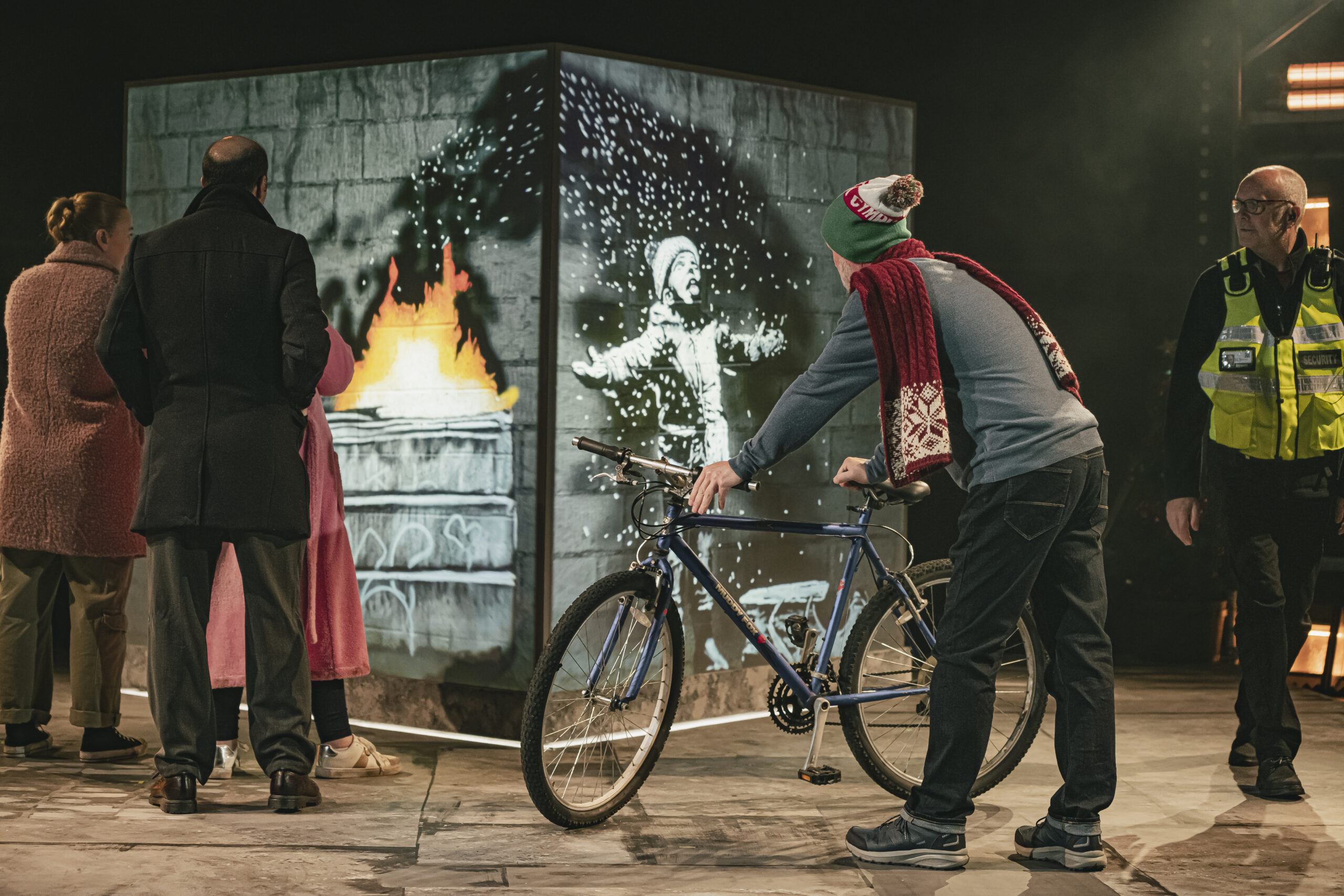I’ve never been much of a fan of verbatim theatre. Arrogantly, I always felt it was a bit like cheating. Because surely it’s harder to craft a compelling piece of dialogue from thin air than simply note down what someone has said? I guess I’m just instinctively drawn to, and impressed by, a story that’s been entirely created from a blank page. But if there was ever a production to change my stance on this, I doubt there could be one better than ‘Port Talbot Gotta Banksy’.
The play, written by Paul Jenkins and Tracey Harris, uses over 150 hours of interviews with the residents of Port Talbot to tell the story of how the town became home to a piece of Banksy street art. One December morning, steelworker Ian Lewis woke to find a piece of graffiti on the side of his garage. Titled Season’s Greetings, but known by most as ‘Port Talbot’s Banksy’, it depicts a child joyfully catching what appears to be snowflakes on his tongue, only for this to be revealed by a second panel as ash rising from a burning bin.
The symbolism of this is debated amongst the town’s residents, with some seeing it as a comment on Port Talbot’s pollution – one character states that it essentially says ‘we’re in hell’ – with others considering it to be more of a bittersweet metaphor for the town’s conflicted relationship with the steelworks and the way it is inevitably entwined with the town’s identity.
The story is told through candid and comic reflections from the real life locals. From steelworkers and councillors to gossiping curtain twitchers, it celebrates a wealth of views about what the artwork means, whether it should be removed or preserved, and crucially, whether it represents an opportunity for a more prosperous future.

Cast of Port Talbot Gotta Banksy – credit Kirsten McTernan
We are guided by an exceptional ensemble cast, with each actor switching between multiple roles with astounding authenticity. Matthew Bulgo excels as both the unassuming, yet adorable Ian Lewis and a pragmatic, cynical council figure. Holly Carpenter, a tremendously gifted comic actor, morphs effortlessly between characters, changing physically and vocally, but never at the expense of truth. Ioan Hefin is quietly devastating as Kevin, a bouncer turned unofficial crowd manager whose stoicism hides deep vulnerability. Simon Nehan stands out as art dealer John Brandler, with a mannered performance that reminded me of a type of Monty Python character Michael Palin would almost certainly have played. Jalisa Phoenix-Roberts demonstrates extraordinary subtlety with masterful control over specific microexpressions, and delivers an unpolished rhythm of speech that is instantly recognisable. And of course, Kerry Joy Stewart is simply unforgettable as the local, vaping gossip – absolutely hilarious and utterly authentic.
The staging is stripped back but effective. A central block acts as a canvas for projections, and predominantly displays the Banksy artwork itself. Direction from Paul Jenkins also ensures a commitment to naturalism from the actors resulting in a palpable warmth which never fails to engage the audience.
Port Talbot Gotta Banksy succeeds because the narrative has been so lovingly constructed by Jenkins and Harris from these real life interactions. You get the impression that these writers fell in love with their interviewees, and their empathy for them bleeds into the eventual portrayal on stage.
The choice of extracts are also used wisely to suggest that the play does not take a side. It does not villanise the councillor for his pragmatism and dismissal of the power of art, nor does it necessarily disprove the perhaps naive optimism of John Brandler. All views are voiced without prejudice in their portrayal, and it is this sentiment which sits at the heart of the play – an ambition to air the opinions of those that matter most, the people of Port Talbot.
A remark made by one of Jalisa Phoenix-Roberts’ characters illustrates the point perfectly: that amongst all the media storm, subsequent debate, and eventual sale of the piece, it felt like no one ever asked the people what they thought. Because this artwork didn’t belong to one person, it belonged to Port Talbot as a whole and it is this notion that fuels the play’s most powerful moment – which I won’t spoil here – but it’s enough to say that the microphone is, at last, handed back to the people who matter most.
Port Talbot Gotta Banksy may have convinced me of the artistic worth of verbatim theatre, but it did so not only through reshaping real life interviews into a compelling and emotionally resonant narrative, but also by proving its ultimate value and purpose: to provide a platform to voices that are too often silenced or ignored. This story isn’t about a mural, it’s a portrait of a community which embraces and celebrates all of its complexity with humour and heart.


